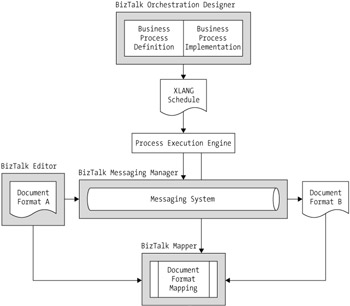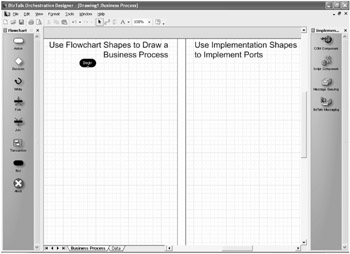Exploring BizTalk Server
BizTalk Server provides a scalable solution for the organization and management of business processes. It can define document formats, map how documents are transformed, and specify how documents are exchanged between applications. BizTalk Server also includes the ability to execute transactions that run as long as weeks or months and enable monitoring and event logging. BizTalk Server was originally intended for document routing, such as product catalogs and shipping orders exchanged between companies and their trading partners . Also, BizTalk Server can send and receive documents across the Internet and ensure data integrity, delivery, and security.
BizTalk Server comprises different applications with different specialties, including document editing, document mapping, messaging and routing management, process definition, process implementation, and process execution. Each application integrates to complete the BizTalk Server process automation solution illustrated in Figure 6-1.

Figure 6-1: BizTalk Server's application components
Understanding the Orchestration Services
BizTalk Orchestration enables the creation of detailed business processes within a visual design environment based on Microsoft Visio. When an organization's business process changes, a business analyst can use the BizTalk Orchestration Designer to specify matching changes (see Figure 6-2). Traditionally, the process definition phase and the process implementation phase happen separately with different tools. In BizTalk Orchestration, both phases happen within the same design environment.

Figure 6-2: The BizTalk Orchestration Designer
Because business processes are defined and implemented side by side, changes to a process definition can easily trigger changes to the implementation. BizTalk Orchestration also provides several other important features to solve tasks that otherwise are hard to accomplish. This includes the ability to create process definitions that branch out into multiple activities at the same time and the ability to create long-running business processes that span different applications, platforms, and organizations.
Understanding the Messaging Services
BizTalk Messaging provides the ability to send and receive business- related documents securely and reliably. An example of such a document could include issue data. BizTalk Messaging is able to pass documents between internal applications and external business partners. This includes defining how documents are received, processed , and delivered to their destinations. It also performs document validation, uses digital signatures, encrypts documents, and guarantees delivery over unreliable transports, such as Hypertext Transfer Protocol (HTTP), Hypertext Transfer Protocol Secure (HTTPS), and Simple Mail Transfer Protocol (SMTP).
Understanding the XML Source Documents
For businesses to exchange documents in an environment where neither side wants to depend on the technology the other side is using, businesses need a universal language in which to write these documents. This universal language has evolved into Extensible Markup Language (XML), a flexible language for document exchange. You can view or edit a business document written in XML with the BizTalk Editor. In the following example, information about a new, high-priority issue appears in an XML document:
<Issue> <Header issueNumber="809" issueStatus="New" issuePriority="High" dateCreated="2003-05-01" timeCreated="13:17:00" /> <Author> Peter Frassmann </Author> <PriorityID> 1 </PriorityID> <Summary> Unable to print. </Summary> <Description> I am unable to print to the //LJ-MARKETING printer from my notebook computer. The problem just started acting up recently. </Description> </Issue>
Although this document appears somewhat unusual, it is still fairly easy to read. The text strictly follows a specific document definition, called a schema . A schema is another XML document that describes the format of an XML data document. A schema does not contain any data itself. It only defines rules for what might appear in an XML data document. Chapter 9, "Using XML and Web Services," goes into deeper detail about XML and how you can apply it.
BizTalk Server natively exchanges XML documents between business partners because data fields are clearly identified and easy to find. BizTalk Server can also create or edit XML documents as an Orchestration schedule is processing.
In addition to XML documents, BizTalk Server can also exchange plain-text documents for applications that only import or export data in fixed-positioned or Comma-Separated Values (CSV) documents. Finally, BizTalk Orchestration provides additional tools that map areas of such text documents into an XML schema for easier integration.
Understanding the XLANG Schedule
After a business analyst has drawn a process diagram in BizTalk Orchestration and the developer has completed the implementation of the process diagram, they compile everything into a single document referred to as an XLANG schedule . The XLANG schedule is a file written in XLANG, which is also based on XML. XLANG describes the logical sequencing of activities that make up business processes, as well as the implementation of business processes, by using various components and technologies.
EAN: 2147483647
Pages: 119
- The Four Keys to Lean Six Sigma
- Key #4: Base Decisions on Data and Facts
- Making Improvements That Last: An Illustrated Guide to DMAIC and the Lean Six Sigma Toolkit
- The Experience of Making Improvements: What Its Like to Work on Lean Six Sigma Projects
- Six Things Managers Must Do: How to Support Lean Six Sigma